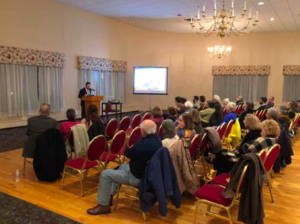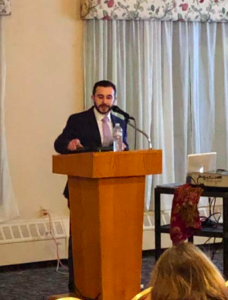On November 13th, University of New Hampshire Adjunct Professor Andrew Ntapalis presented his research and findings about a controversial and misunderstood figure in Greek history and literature, the ‘Romios.’ At the event, sponsored by the Boston Lykeion Ellinidon’s Guardianship of the Greek Language Department and held at the Hellenic Cultural Center in Watertown, Massachusetts, Ntapalis urged the audience to challenge the modern understanding of a Romios as a stubborn, low-class modern Greek who does not aspire to the ideals of Hellenism. Instead, he argued, the Romios is better understood as the steadfast guardian of a different type of identity – the Orthodox Christian living in subjugation under the Muslim Ottoman Empire.
Ntapalis set the stage by taking his audience on a journey through the etymology of the Romios from its beginnings as a word for Roman, which the Greeks of the Eastern Roman Empire termed themselves, to the various shades and subtleties of meaning that arose after the Ottoman conquest. After the loss of a central government, Ntapalis explained, the most potent touchstone of identity under the Ottomans was religious, not ethnic or cultural. The largest religious minority in the empire were Christians. Therefore, he explained, a Greek-speaking Christian would have aligned themselves with a Bulgarian-speaking Christian over a Greek-speaking Muslim.
As Orthodox Christians, the highest heroic ideal for the Romios is what Ntapalis terms “steadfastness,” a refusal to capitulate in terms of faith and to instead suffer, as Christ suffered.
Ntapalis in his research has compared demotic songs of the Greeks that depict the Romios with examples from Orthodox hagiography, particularly the Lives of the New Martyrs. He believes that he has identified not only a common motif, but even a tradition for songwriters to borrow from the New Martyrs to describe a heroic ideal of Christian steadfastness. The highest virtue was to remain faithful to Christ, to bear the suffering of subjugation in a Christ-like manner. For the Romios, the endurance of suffering brought one closer to God.
The motif of suffering as a Christian ideal is most evident in the Lives of the New Martyrs, a collection of stories about men and women who had suffered in the name of their Christian faith. Ntapalis drew our attention to the story of George of Bulgaria, a Christian soldier in the Ottoman army who was accused of blasphemy, a capital offense, when he defended Christ. George was offered a way to escape death by converting to Islam, along with rich gifts, but he refused. Even when he was jailed, he was offered the chance to escape, but he stayed and suffered as a testament to his faith.
Ntapalis theorizes that this pattern of events – a Christian in struggle who is offered the chance to live, and even become wealthy, if they convert, but who instead chooses to die – is repeated in the Demotic folksongs in deliberate imitation of the stories of the martyrs. He highlighted the popular Demotic song “Ο Κάστρος Της Ωραίας.” This song recounts the siege of a Byzantine castle, possibly Salmeniko, by the Ottoman army. For twelve years, the song tells us, the hero, a young Romia, guarded the castle by day and by night and refused to open the doors to anyone. The Romia’s struggle is not simply physical; she must also be steadfast in her faith even when all seems hopeless. One day, one of the Sultan’s servants saw her and desired her. He went to the Sultan and said “if I can take the castle, what will you give me?” The Sultan offered him money, jewels, and horses, before offering him the girl. The song calls the servant a Turk, even though he was “the son of a Romia.” So, even though he was a Greek-speaking son of a Orthodox Christian woman, because he was a Muslim in the voluntary service of the Sultan, he was a Turk. The servant approaches the door in the guise of a Christian monk and asks her to let him in. She lets him in, but as soon as she does, she realizes that she has been tricked and throws herself off the walls, taking her own life.
This ideal of steadfastness is also present in the songs about heroes of the Greek resistance and revolution. Many heroes, such as Athanasios Diakos, have similar elements in their stories: they are engaged in struggle with the Ottomans, they are offered a way out – through conversion – and rich gifts, but they refuse to become a Turk and would rather die. In the song about the death of Diakos, he says “I was born a Greek, I will die a Greek.’” While in Modern Greece, many Greeks derive their sense of self-identity with links to Hellenism and the Classical past, the Romios is different. Ntapalis challenges us to step away from our modern connotations of the Romios and try to understand this figure as it may have been understood in different times and different circumstances. Under the Ottoman conquest, the Romios identified with a Christian identity, which was how they engaged with the daily struggle during the occupation, and upheld the ideal of steadfastness in their faith.

